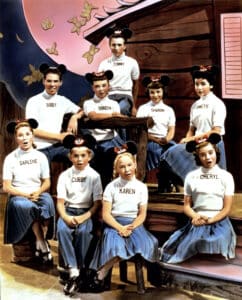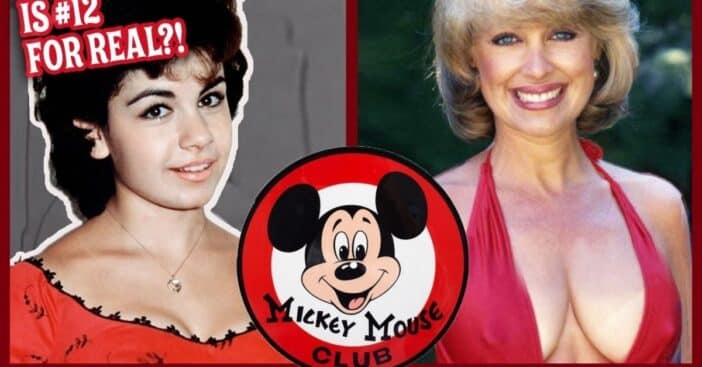
UPDATED 1/11/2023
Who’s the leader of the club that’s made for viewers across America? M-I-C-K-E-Y! Mickey, indeed! Young TV-watchers were drawn to The Mickey Mouse Club, where they got to see other kids, really talented kids, making a show. The skits lived up to their name, watching “Fun with Music” and other vignettes these Mouseketeers put on. This was also an incredible opportunity for a kid’s first job; the club was to child actors what SNL has been for up-and-coming comedians.
It’s time to uncover the secrets behind this revolutionary show. Was everything as wholesome behind the scenes as it appeared on-screen? Hardly. How much money did these children, plucked into fame by Walt Disney, make? It’s time to find out all this and more. Mouseketeers, march!
A First Time for Everything

Debuting on October 3rd, 1955, The Mickey Mouse Club truly broke ground. It was the first show for kids starring primarily just kids. That hadn’t been done before, which made children around the world want to watch. It felt like they were talking straight to us and they taught lessons and skills that were important to cultivate at such an early age.
RELATED: The Wealthiest People Who Started On ‘The Mickey Mouse Club’
This revolutionary step also meant young viewers wanted to participate with the Mouseketeers, and in turn, we began to learn things, develop an ear for music and rhythm, build interpersonal skills, and get a glimpse of Disney in other countries through the newsreels. Not only was this one of the first educational programs for kids, but it also set the bar very high.
Building the Magic

Believe it or not, The Mickey Mouse Club was essentially a means to an end, not an original goal itself. Jump back over six decades, and Walt Disney had a different project in mind: he wanted to build a place known today as Disneyland. The only problem was it needed financing. It’s hard to imagine the Disney name not being a billion-dollar titan, but even this studio had some humble beginnings.
So, Disney had to brainstorm moneymaking ideas. He approached ABC with a few different pitches, and studio execs perked up at the proposal that ended up being The Mickey Mouse Club.
Technically, the idea for this group traces back to the 1930s, when there was a theater-based Mickey Mouse Club — an organization — based in Ocean Park, California’s Fox Dome Theater, that would expand to sixty theaters hosting the group. Two years later, the club had over a million members and expanded into a UK branch. It dissolved for a few decades, then re-emerged and reimagined as the children’s variety show.
Parental Supervision Discouraged

The Mickey Mouse Club was a monumental break into the industry for countless kids, the dream, one might say. Of course, their parents wanted to see them succeed, too, something they got a front-row seat to since they had to stick around while their kids worked. That also meant the parents had to behave like well-mannered employees just as much as the kids, because the producers had a job to do, and if the parents got in the way, their kid could get fired to remove the problem.
One big example was Nancy Abbate, who brought a really strong dancing background to the cast. Unfortunately, her guardians were guilty of “parental misbehavior” and she was let go after the first year. Though other sources say she wanted to do other work, and that she left the show voluntarily after refusing to go on the aerial wires at the Disneyland circus.
Generally, the parental issues behind the scenes were constant nudges for their respective kid to have a longer chance in the spotlight. Other times, parents thought they knew better and began directing their own children, like when a parent does all the science homework for their child — everyone knows it. So, the crew arranged some changes, for the parents to be there, but at a distance. And this tweak had the kids behaving much better, along with the parents.
Kiddy Casting Call
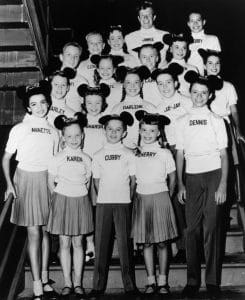
This club was made for you and me, where they made us feel as welcome as can be. And to do that, everything had to feel familiar, relatable. So, when it was time to cast the talented little “mice,” Walt Disney laid out one big ground rule: no glamorous stars, no Shirley Temples, no stage moms. No unnaturally cute cast members that started out as the most adorable thing to hit the screen. When producers first began casting, picture-perfect is what they were going for, but they ended up switching gears just months before things kicked off to accommodate this requirement.
That did make for some uncomfortably tough decisions. Disney wanted a balanced cast of boys and girls. But at that time, more girls were taking tap dance than boys, and so some boys without any real dance experience were brought on over perfectly qualified girls.
Adult Admission
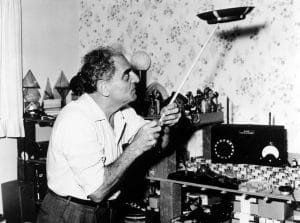
The Mickey Mouse Club was mostly starring kids for kids, but of course, there were plenty of important adult minds and talents involved as well. All around the world, viewers marched to the beat created by Jimmie Dodd, the songwriter behind “The Mickey Mouse Club March” and who was tasked with being the leader of the Mouseketeers. He got the job by creating “The Pencil Song” for his audition, proving he could make a catchy jingle out of any mundane thing with a split second’s notice. On top of that, who could forget those little lessons he taught, according to the philosophy known as Doddisms?
Roy Williams had a similar talent for spontaneity, this time with drawing. He could get a quick read on a character or scene and create a caricature in the blink of an eye, so at first, he sat in on creative meetings and drew up storyboards then and there. But Disney took one look at this guy and told him, “You’re big and goofy-looking, you should be the Big Mooseketeer.” Just like that, Williams went right along to get sized for his own ears. Fittingly, Roy himself was the brain behind the ears in the first place, based on a gag where Mickey takes off his ears like a gentleman would take off a tophat.
Finally, there was Alvy Moore, originally destined to be the Roving Mouseketeer, but ultimately restricted to voice-over work for the show. Moore may not have been seen, but was heard in a very important way.
Trio of Trouble
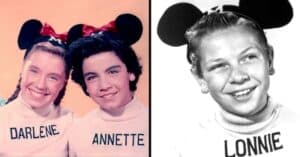
The Mickey Mouse Club transformed a few children into worldwide stars, exemplified by Lonnie Burr, Annette Funicello, and Bobby Burgess. Walt Disney discovered Annette personally after seeing her in a school production of Swan Lake, an idea of her mother’s to help the young girl overcome her shyness. That’s one plan that succeeded.
Like a lot of rising stars at the time, Annette pondered the idea of changing her name for a stage name, but Walt Disney actually told her to keep it as-is and figured the show would help make it unforgettable. Turns out, he was right. Annette became half of a battle for mouse supremacy with co-star Darlene Gillespie. The two were locked in a back-and-forth brawl for the title of favorite Mouseketeer until suddenly Annette sped into first place.
It wasn’t so easy for Lonnie Burr. Yes, he became famous, and we know too well how that can make a child star spiral one way or another — goodness knows plenty of adults fall under the pressure. Sure enough, once the series ended, Burr realized how being an idol had affected him. In an interview, he explained, “A child accepts that adulation as love, and when you take that away, it’s hard to understand it wasn’t real.”
Money, Money, Money
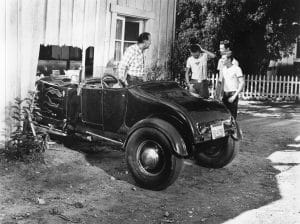
These little actors got their own contracts, which granted them $185 per day; since the kids worked a six-day workweek that comes to $1110 a week. Burr actually said that was more than his dad made as a truck driver.
But their contracts came with some fine print to watch out for. For example, there were 13-week options written in; essentially, the producers had plenty of opportunities to decide if they wanted to keep an actor or not. This was a warning to the kids and their parents.
Their contracts also required them to perform at other venues, wherever and whenever the studio wanted — and no, they wouldn’t be paid more for that performance. Some of these trips included visits to hospitals, promotional photoshoots, and of course Disneyland. If anyone complained, they would not be brought back to the show.
A Hairy Situation
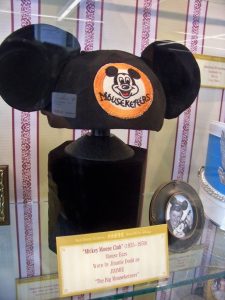
Most Disney fans have at least one pair of mouse ears at some point. In each episode, the young cast wore them like a school uniform. Fittingly, like so many students with uniforms, much of the young cast hated them.
You can’t fully blame them; the setup was counterintuitive. The show and its cast needed to reflect trends of the time, which meant big waves, dovetails, tumbling curls, elephant trunks, and razor-straight parts were all the rage.
That meant hours of fussing, washing drying, combing, and styling hair, before sealing it all up with gooey product. Then, they got to do it all over again once the actors sweated up a mess from the dance numbers. For further context explaining their dismay, this happened multiple times a day. To top it all off — literally — they went and disturbed all that timely styling by shoving on that Mickey headwear.
Trouble in Paradise
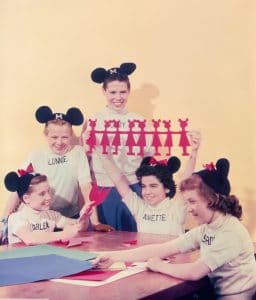
Kids are temperamental, and sometimes a child actor could go too far, and get fired from the club. Sometimes, the kids could be instigators. The most infamous example would be Mickey Rooney Jr. and his brother Timmy, who caused a mess in the studio’s paint department. Needless to say, they were not asked to return. Then there was Paul Peterson who was fired for punching a casting director in the stomach.
But other times the kids were confronted with some intimidating situations orchestrated by the adults. Dallas Johann might have become another world-renowned Mouse, but he cried whenever the cameras pointed his way. Nancy Abbate left after refusing the aerial acrobatic routines, complete with ropes and rings.
Additionally, just like TV stars worry about dreadful typecasting, a few child stars were forever chained to those ears. In the battle for popularity with Annette, Darlene Gillespie came in second, but she was still locked in a contract with Disney. Specifically, the empire claimed ownership over her voice, and this discouraged other production companies from working with her.
The End…For Now
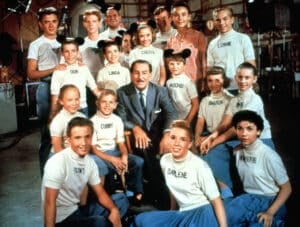
Season one alone brought ten million viewers to The Mickey Mouse Club and sparked two million dollars worth of Mouse-ear sales in just three months. This was a turning point for television producers showing that there was success to be had in kids’ shows. And Disney producers were doing it well, because the show continued for four seasons at the top of the ratings.
So why did it end?
Ultimately, the show was very costly to produce. It had a big cast to support each episode, plus production and location. They relied a ton on commercials to make a profit, but the whole educational television thing was kind of new, and the top sponsors didn’t flock to it. Ultimately, Walt Disney and the studio couldn’t agree on anything to keep the show going, so after four seasons in 1959, ABC canceled it.
Then, ABC prohibited The Mickey Mouse Club from airing on any other network. After creating such a great thing together, network and icon ended up in a lawsuit that Disney won citing damages done, but they still couldn’t air it — or Disney’s Zorro series — on other networks.
Gather round, Mouseketeers. Were you a Mickey Mouse Club fan? Can you remember memorizing each day’s theme? And, of course, who was your personal favorite Mouseketeer?
